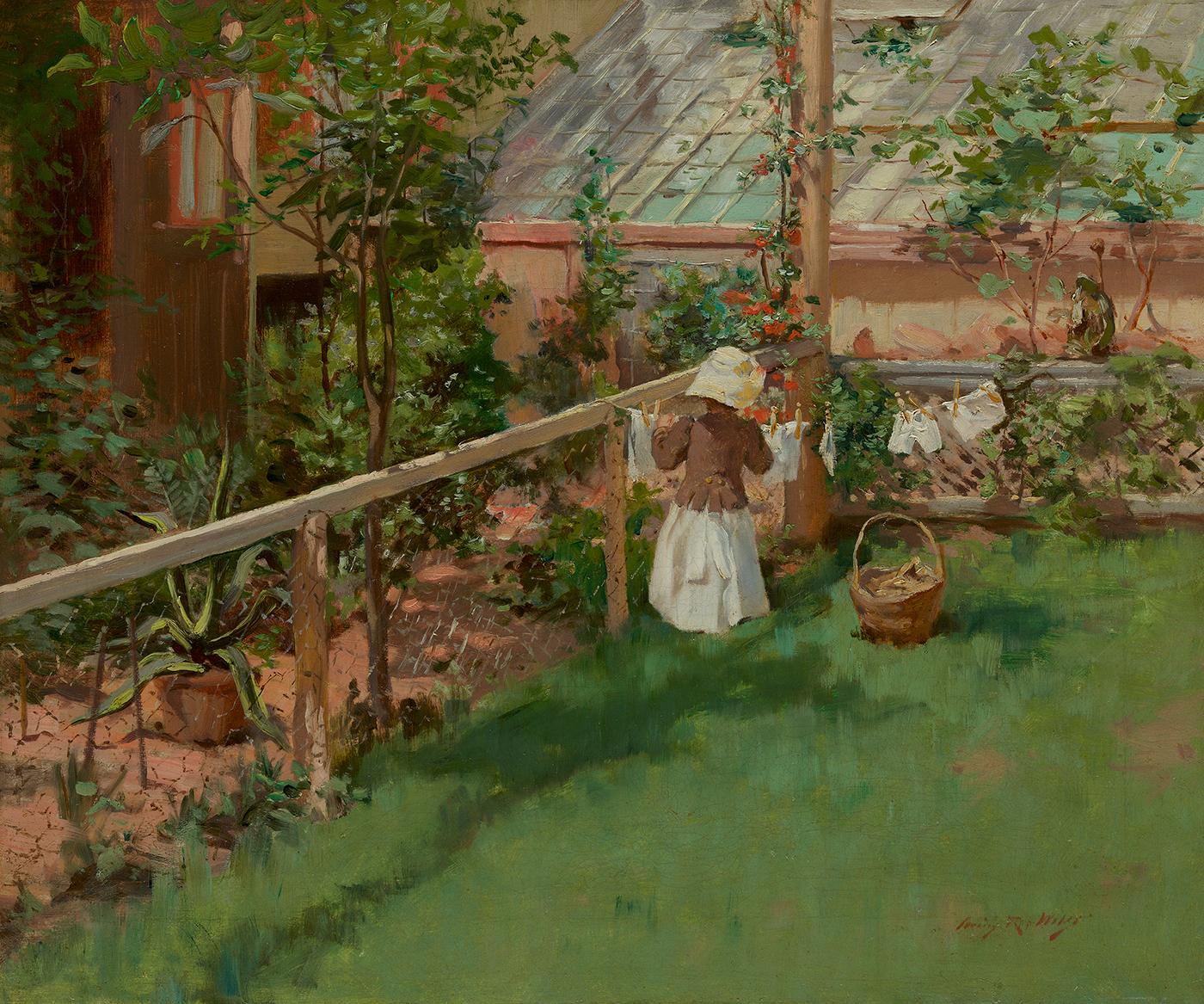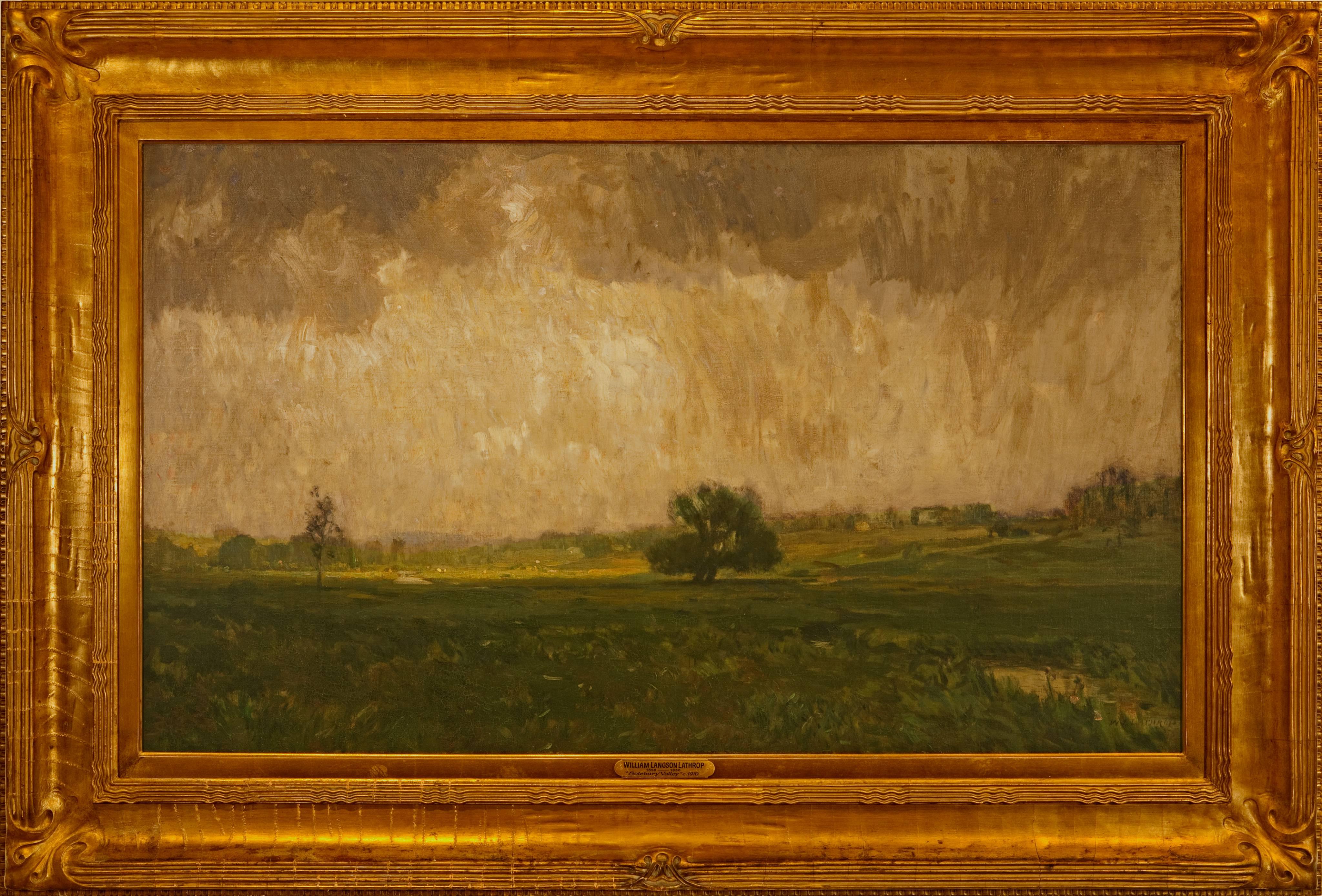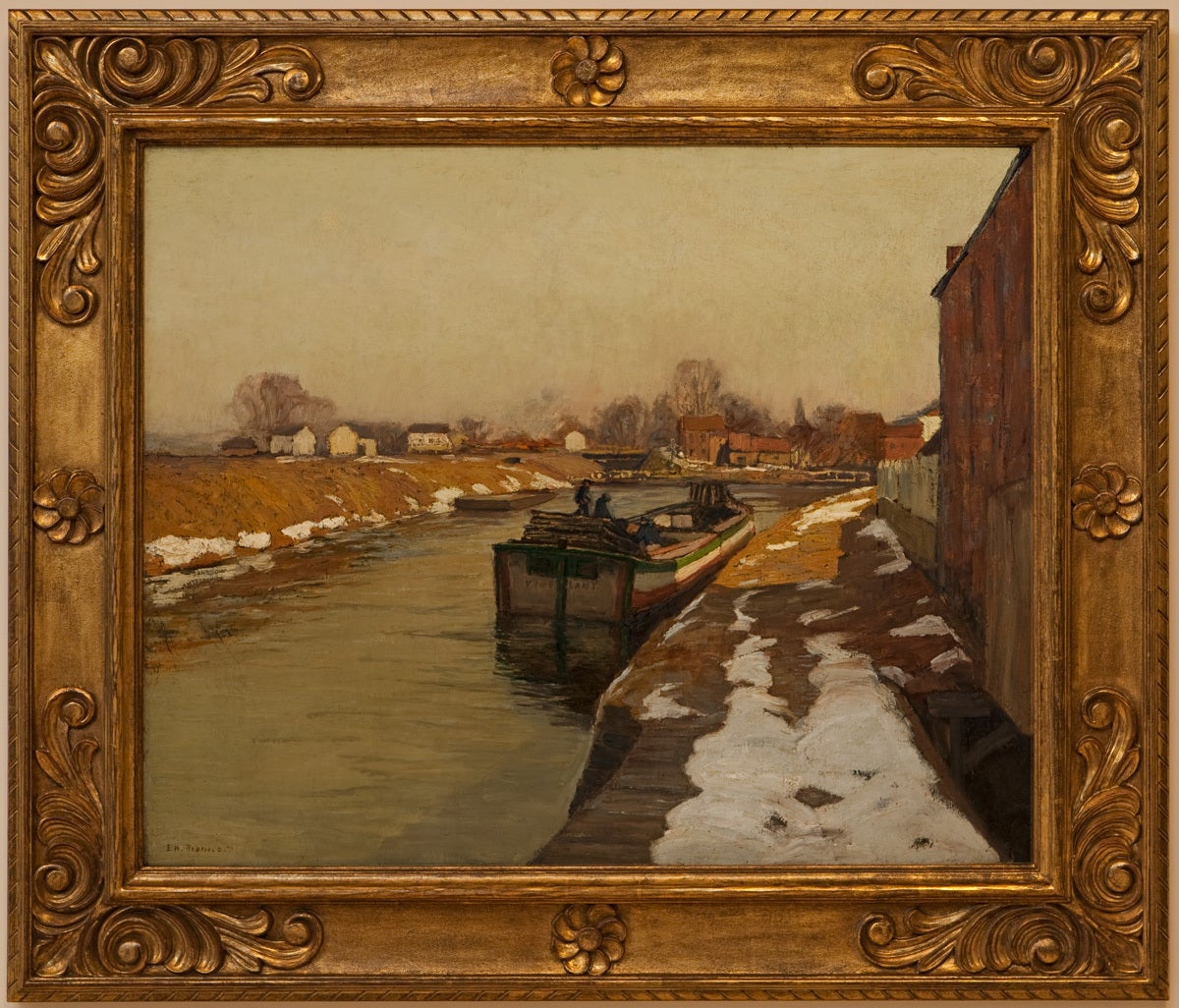Jacques Zucker"Rockport Quarry" Impressionistic Oil Painting Landscape Overlooking Houses1944
1944
About the Item
- Creator:Jacques Zucker (1900 - 1981, American)
- Creation Year:1944
- Dimensions:Height: 36 in (91.44 cm)Width: 43 in (109.22 cm)Depth: 2.5 in (6.35 cm)
- Medium:
- Movement & Style:
- Period:
- Condition:With ordinary wear from age with a tiny pinhole lower right and some wear to surface, the frame also shows some signs of wear and scuffs from age, chips and minor imperfections in line with manufacturing period.
- Gallery Location:New York, NY
- Reference Number:Seller: 0029371stDibs: LU9824698712
Jacques Zucker
Jacques Zucker was a prolific artist whose works are exhibited in museums and galleries around the world. Being heavily influenced by artists such as Chaim Soutine, Marc Chagall and Pierre-Auguste Renoir, we can see hints of their styles suggested in many of his works. Although he was very fond of these artists, Zucker's works are mainly impacted by his travels to Paris, America and France. Many of his works depict city street scenes, the seashore, flower still life and portraits of friends and relatives. He has developed a style completely apart from his influences, creating works that are rich in texture, color and emotion.
- ShippingRetrieving quote...Ships From: New York, NY
- Return PolicyA return for this item may be initiated within 7 days of delivery.
- "Washington Square Park in Snow" Impressionist Winter Street Scene Oil on CanvasBy Johann Berthelsen, 1883-1972Located in New York, NYA truly stunning jewel and pertinent example of Berthelsen's charming New York City winter scenes depicting Washington Square Park in the snow. An iconic scene that so many have come...Category
Mid-20th Century American Impressionist Landscape Paintings
MaterialsOil, Canvas
- "Rain by the Met" Impressionistic Ashcan School New York City SceneBy Cindy ShaoulLocated in New York, NYAn impressionistic depiction of people walking about near the Metropolitan Museum on a rainy day. A man walks quickly holding a briefcase, a group of woman huddled together under one umbrella; this painting goes back in time as the artist captures the style and trend of the early 20th Century with old cars parked in the distance and fashion of the people. A wonderful piece evoking an emotion bringing us into the past with this whimsical scene. This painting is signed lower left and it comes framed in gold tone frame with hanging wire on verso ready to be displayed. Art measures 16 x 20 inches Frame measures 19.5 x 23.5 inches Inspired by whimsey and purity of the feminine form, Cindy Shaoul is known for her impressionistic and abstract style. She is best recognized for her series ‘Brides’, ‘Dripping Dots’ and ‘Hearts’, as well as her ‘Plein-Air’ street scenes of quintessential New York locations. Shaoul’s works can be found in hundreds of private and corporate collections worldwide. Since her first group show at Parsons School of Design in 2009, her work has been showcased internationally – from Italy to South Korea – and has been shown at various art fairs nationwide including Miami, Palm Beach, Dallas, and New York. Shaoul has had numerous solo exhibitions and has garnered the attention of notable celebrities such as Emma Roberts, Lily Collins, Ashley Park, Catherine Deneuve and John Malkovich. Her love of painting began at the age of 18 when she was on Thanksgiving break from college. She painted a 9-foot colorful, abstract mural in her mother’s art...Category
2010s American Impressionist Landscape Paintings
MaterialsCanvas, Oil
- "Boats on The Canal" British American Impressionist Oil Painting on CanvasBy John ClymerLocated in New York, NYA masterful oil painting depicting a countryside village scene with boats on a canal next to a stone arched bridge by British American artist John Clymer. As an Impressionist painter...Category
Early 20th Century American Impressionist Landscape Paintings
MaterialsOil, Canvas
- "Figures in the Village" British American Impressionist Oil Painting on CanvasBy John ClymerLocated in New York, NYA masterful oil painting depicting a countryside village scene with figures by British American artist John Clymer. As an Impressionist painter, he was known for his pastoral landscapes depicting scenes from daily life; notably provincial French towns. He also created numerous views of city life during his stays in Paris. This piece is an excellent example of the works produced during the 1950's with use of a rich color pallet and layers of paint giving this work such a stunning representation of country life. The way he uses flecks of light dashed onto the canvas creates a joy for the viewer to experience. This painting is signed by the artist lower right and it comes comes housed in a beautiful gold tone wood carved frame with linen liner and hanging wire on verso ready to be displayed. Art measures 12 x 16 inches Frame measures 17.5 x 21.5 inches John Clymer was born near Brighton, England in 1932. At a very early age, he exhibited definite artistic talents. His father immediately recognized his son's gift and enrolled him at the royal art academy. John was soon swept by the serenity and tranquility of the impressionists. His favorites ranged from Monet to Pissaro and Sisley; eventually leading to an awakening interest in the magnificent Turners at Tate galleries. Clymer's serene yet colorful canvasses ably depict his love for the southern english coastline. Demand for his canvasses is very high in the United States and the European continent while still relatively dormant in his home country. PROVENANCE: Private collection Westville, New Jersey; Lilac Gallery...Category
Early 20th Century American Impressionist Landscape Paintings
MaterialsOil, Canvas
- "View of the Empire State NYC in Snow" Impressionistic Ashcan School StyleBy Cindy ShaoulLocated in New York, NYAn impressionistic depiction of a figure in the snow with cars and buildings in the busy City Streets. The Empire State Building is portrayed in the background as the snow filled str...Category
2010s American Impressionist Landscape Paintings
MaterialsCanvas, Oil, Board
- "Brunch at 12 Chairs" Plein Air Restaurant Oil Painting in Soho New York CityBy Cindy ShaoulLocated in New York, NY"With shades of Pierre Bonnard’s Parisian street vistas and Edward Hopper’s New York shopfronts, American impressionist Cindy Shaoul’s oil paintings depict the much-loved locales and...Category
2010s American Impressionist Landscape Paintings
MaterialsCanvas, Oil
- At the ClotheslineBy Irving Ramsey WilesLocated in New York, NYSigned lower right: Irving R. WilesCategory
Late 19th Century American Impressionist Landscape Paintings
MaterialsCanvas, Oil
- "Alley Fiends"By John R. GrabachLocated in Lambertville, NJJim’s of Lambertville is proud to offer this artwork by: John R. Grabach (1886 - 1981) John Grabach was a highly regarded New Jersey artist, teacher, and author of the classic text...Category
1930s American Impressionist Landscape Paintings
MaterialsCanvas, Oil
- "Forest Strongholds"By John F. CarlsonLocated in Lambertville, NJSigned lower right. Complemented by a hand carved and gilt frame. Exhibited at the National Academy of Design, 1928Category
20th Century American Impressionist Landscape Paintings
MaterialsCanvas, Oil
- "Solebury Valley"By William Langson LathropLocated in Lambertville, NJSigned lower right. Complemented by a period frame. William L. Lathrop (1859-1938) Deemed “Father of the New Hope Art Colony”, William Langson Lathrop was born in Warren, Illinois. He was largely self-taught, having only studied briefly with William Merritt Chase in 1887, at the Art Students League. Lathrop first moved east in the early 1880s, and took a job at the Photoengraving Company in New York City. While there, he befriended a fellow employee, Henry B. Snell. The two men became lifelong friends and ultimately, both would be considered central figures among the New Hope Art Colony. Lathrop's early years as an artist were ones of continuing struggle. His efforts to break through in the New York art scene seemed futile, so he scraped enough money together to travel to Europe with Henry Snell in1888. There he met and married an English girl, Annie Burt. Upon returning to New York, he tried his hand at etching, making tools from old saw blades...Category
1910s American Impressionist Landscape Paintings
MaterialsCanvas, Oil
- Winter MoonlightBy George William SotterLocated in Lambertville, NJsigned lower rightCategory
1910s American Impressionist Landscape Paintings
MaterialsCanvas, Oil
- "The Canal"By Edward Willis RedfieldLocated in Lambertville, NJJim’s of Lambertville is proud to offer this artwork. Signed lower left. Complemented by a hand carved and gilt frame. Illustrated in "Edward Redfield: Just Values and Fine Seeing" by Constance Kimmerle and the Pennsylvania Academy of the Fine Arts's Exhibition of Paintings by Edward Redfield (April 17 to May 16, 1909) brochure Edward Willis Redfield (1869 - 1965) Edward W. Redfield was born in Bridgeville, Delaware, moving to Philadelphia as a young child. Determined to be an artist from an early age, he studied at the Spring Garden Institute and the Franklin Institute before entering the Pennsylvania Academy from 1887 to 1889, where he studied under Thomas Anshutz, James Kelly, and Thomas Hovenden. Along with his friend and fellow artist, Robert Henri, he traveled abroad in 1889 and studied at the Academie Julian in Paris under William Bouguereau and Tony Robert-Fleury. While in France, Redfield met Elise Deligant, the daughter of an innkeeper, and married in London in 1893. Upon his return to the United States, Redfield and his wife settled in Glenside, Pennsylvania. He remained there until 1898, at which time he moved his family to Center Bridge, a town several miles north of New Hope along the Delaware River. Redfield painted prolifically in the 1890s but it was not until the beginning of the twentieth century that he would develop the bold impressionist style that defined his career. As Redfield’s international reputation spread, many young artists gravitated to New Hope as he was a great inspiration and an iconic role model. Edward Redfield remained in Center Bridge throughout his long life, fathering his six children there. Around 1905 and 1906, Redfield’s style was coming into its own, employing thick vigorous brush strokes tightly woven and layered with a multitude of colors. These large plein-air canvases define the essence of Pennsylvania Impressionism. By 1907, Redfield had perfected his craft and, from this point forward, was creating some of his finest work. Redfield would once again return to France where he painted a small but important body of work between 1907 and 1908. While there, he received an Honorable Mention from the Paris Salon for one of these canvases. In 1910 he was awarded a Gold Medal at the prestigious Buenos Aires Exposition and at the Panama-Pacific Exposition of 1915 in San Francisco, an entire gallery was dedicated for twenty-one of his paintings. Since Redfield painted for Exhibition with the intent to win medals, his best effort often went into his larger paintings. Although he also painted many fine smaller pictures, virtually all of his works were of major award-winning canvas sizes of 38x50 or 50x56 inches. If one were to assign a period of Redfield’s work that was representative of his “best period”, it would have to be from 1907 to 1925. Although he was capable of creating masterpieces though the late 1940s, his style fully matured by 1907 and most work from then through the early twenties was of consistently high quality. In the later 1920s and through the 1930s and 1940s, he was like most other great artists, creating some paintings that were superb examples and others that were of more ordinary quality. Redfield earned an international reputation at a young age, known for accurately recording nature with his canvases and painting virtually all of his work outdoors; Redfield was one of a rare breed. He was regarded as the pioneer of impressionist winter landscape painting in America, having few if any equals. Redfield spent summers in Maine, first at Boothbay Harbor and beginning in the 1920s, on Monhegan Island. There he painted colorful marine and coastal scenes as well as the island’s landscape and fishing shacks. He remained active painting and making Windsor style furniture...Category
Early 1900s American Impressionist Landscape Paintings
MaterialsCanvas, Oil






